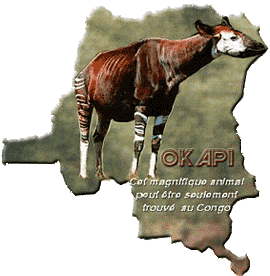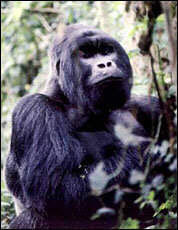 TOURISM AND SITES OF INTEREST... TOURISM AND SITES OF INTEREST... |

Note: Democratic Republic of Congo has a strong touristic potential to develop and following, you can find some examples. Nevertheless DRC is still involved in several conflicts and it is not recommended to travel around.
 Kinshasa Kinshasa
The capital does not have many sights of historic interest, but the visitor interested in the past should not miss the prehistoric and ethnological museums at Kinshasa University, an ensemble of light, rectangular, well laid-out buildings standing on a hillside. A brightly-coloured chapel crowns the top of the hill. Nearby is a corner of the equatorial forest surrounding a beautiful lake called Ma Vallée with a tavern on its banks.
Other attractions include the fishing port of Kinkole, the Gardens of the Presidential Farm of Nsele made of pagodas, and the extensive pools where angling and swimming may be enjoyed. In both the markets and the suburbs of Kinshasa there are craftsmen who produce wood and metal items. The National Museum includes some unique pieces of national art.
 Southwest Congo & Bandundu Southwest Congo & Bandundu
The Insiki Falls (60m/197ft high) at Zongo and the caves in the region of Mbanza-Ngungu may be visited in one day, but it is preferable to stay for two or three days, for Mbanza-Ngungu is a pleasant resort with a good climate. While in the Mbanza-Ngungu area the visitor should stop at Kisantu to visit the Frère Gillet Botanic Gardens with their world-famous rare orchids.
Further west are the wild slopes and gorges of the River Kwilu, 120km (75 miles) from Mataoi; on the right bank of the river is a spot of rugged beauty called Inga. The woods, caves and waterfalls of Boma and equatorial Mayumbe and the Tombs of Tshela can be visited on the way to the ocean beach of Moanda.
Less easily accessible is the upper valley of the Kwango in the southwest. A long journey through a region of unspoiled natural beauty leads to the Tembo (formerly Guillaume) Falls.
|  Kasai & Shaba Kasai & Shaba
In the south, the Upemba National Park straddles the River Lualaba, northeast of Bugama, and includes several lakes inhabited by hippos, crocodiles and numerous aquatic birds. Here too are fishermen, cattle farmers and peasants, as well as a number of mining communities. Kananga and Mbuji-Mayi are typical tropical towns; Kalemie and the banks of Lake Tanganyika are reminiscent of the French Riviera.
The whole of the south is dotted with freshwater lakes such as Munkamba, Fwa and Kasai; there are also numerous impressive waterfalls, such as Kiobo, on the River Lufira, and Lofol, 384m (1259ft) high, north of Lubumbashi.
 Upper Congo & the Kivu Upper Congo & the Kivu

The high plateaux of Congo extends across the eastern part of the country, around lakes Tanganyika, Kivu, Edward, Albert and Bukavu. Bunia is a small, pretty town featuring villas, restaurants and hotels.
In the north is the Garamba National Park, covering 400,000 hectares and featuring lions, leopards, elephants, rhinos and giraffes. Lake Albert, which contains more fish than any other lake in Africa, lies at an altitude of over 618m (2027ft). It can be reached from Bunia, which is also the point of departure for numerous excursions into the forests and mountains, native villages, the Caves of Mount Hoyo and the Escaliers de Venus Falls.
Lake Edward is the home of birds of all sizes and colours. The highest peak in the Ruwenzori range is the Pic Marguerite, at an altitude of 5119m (15,795ft). The snowline is at 450m (1776ft). This region is also inhabited by gorillas and by the extremely rare okapi. The mountain scenery between Goma and Beni is regarded as some of the most spectacular in Africa, although the road is bad.
 Virunga National Park Virunga National Park
Covering an area of 12,000 sq km (4633 sq miles), this comprises an immense plain bounded by two jagged mountain ranges that serve as a natural enclosure for the animals which roam at liberty in this huge natural reserve. Game includes numerous lions, elephants, buffaloes, warthogs, antelopes, hippos and colourful aquatic birds. In this park, near Goma, it is possible to climb the still active volcanoes of Nyamuragira, 3055m (10,022ft), and Nyiragongo, 3470m (11,385ft). |

